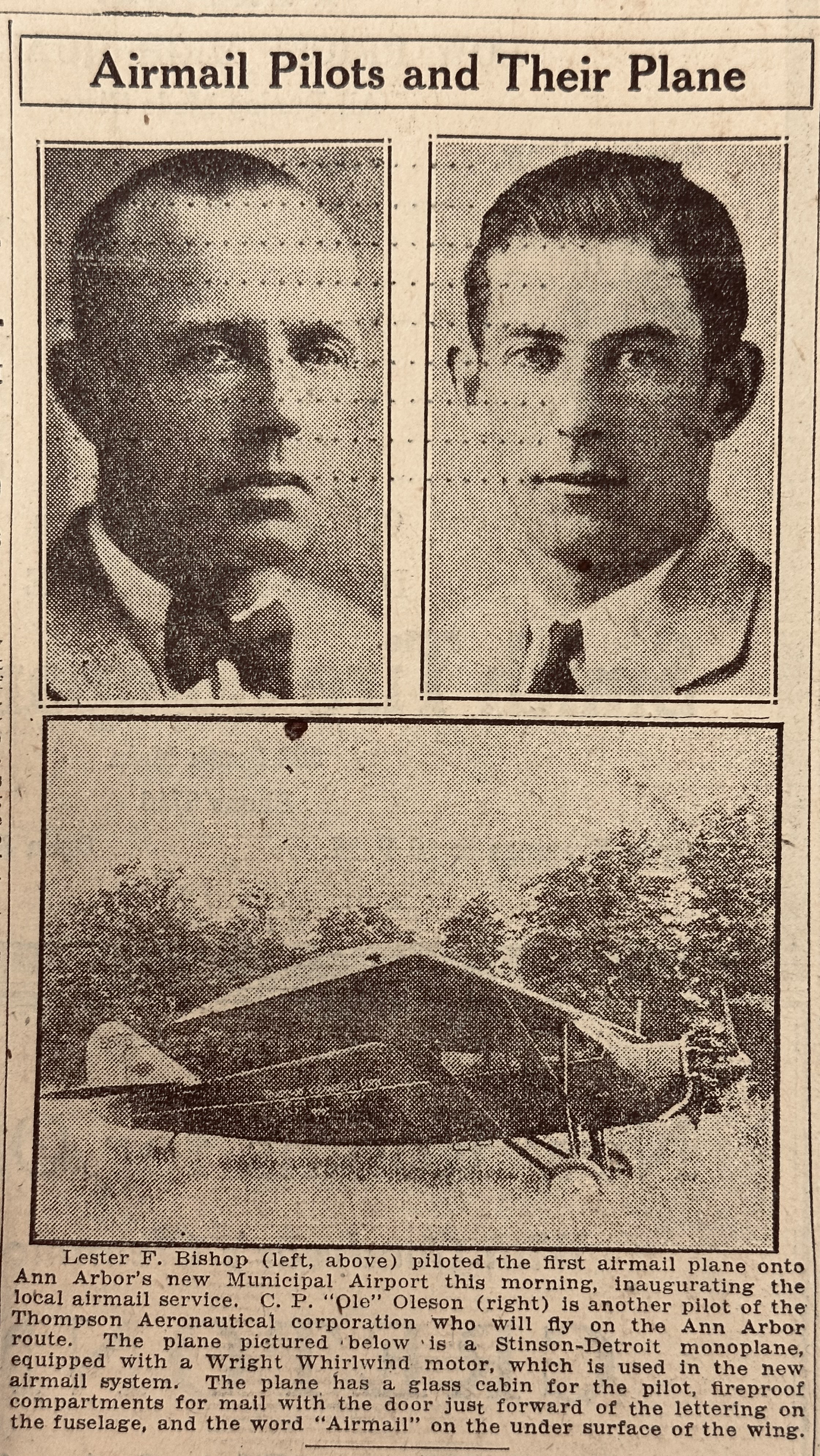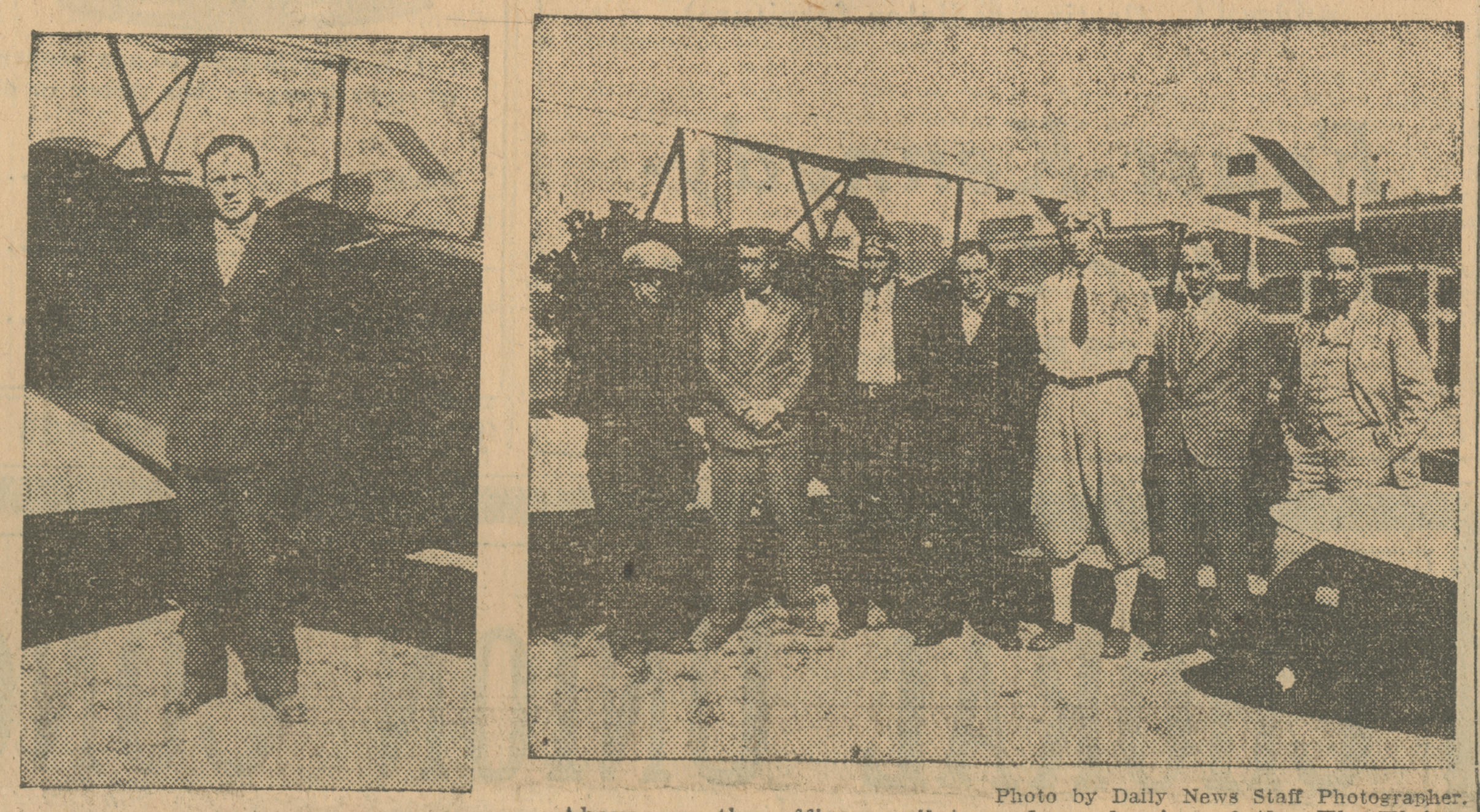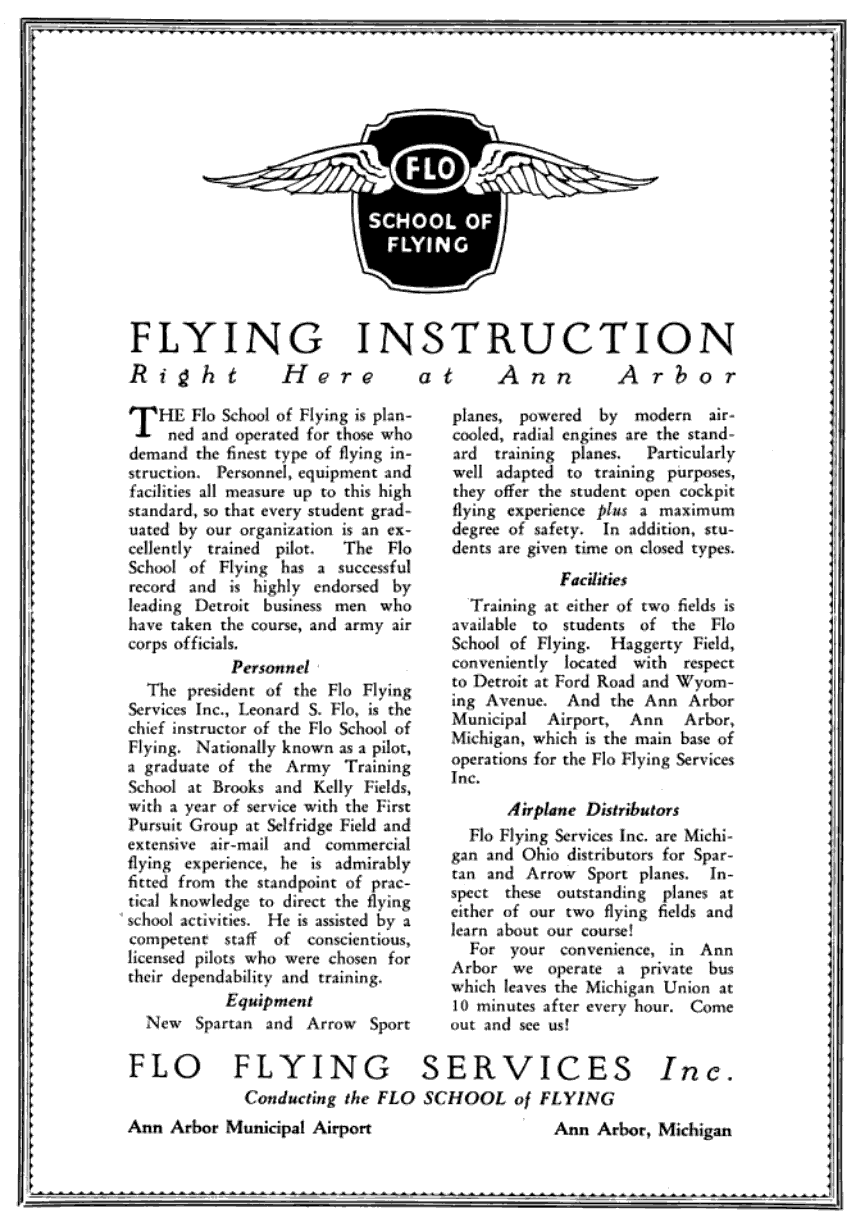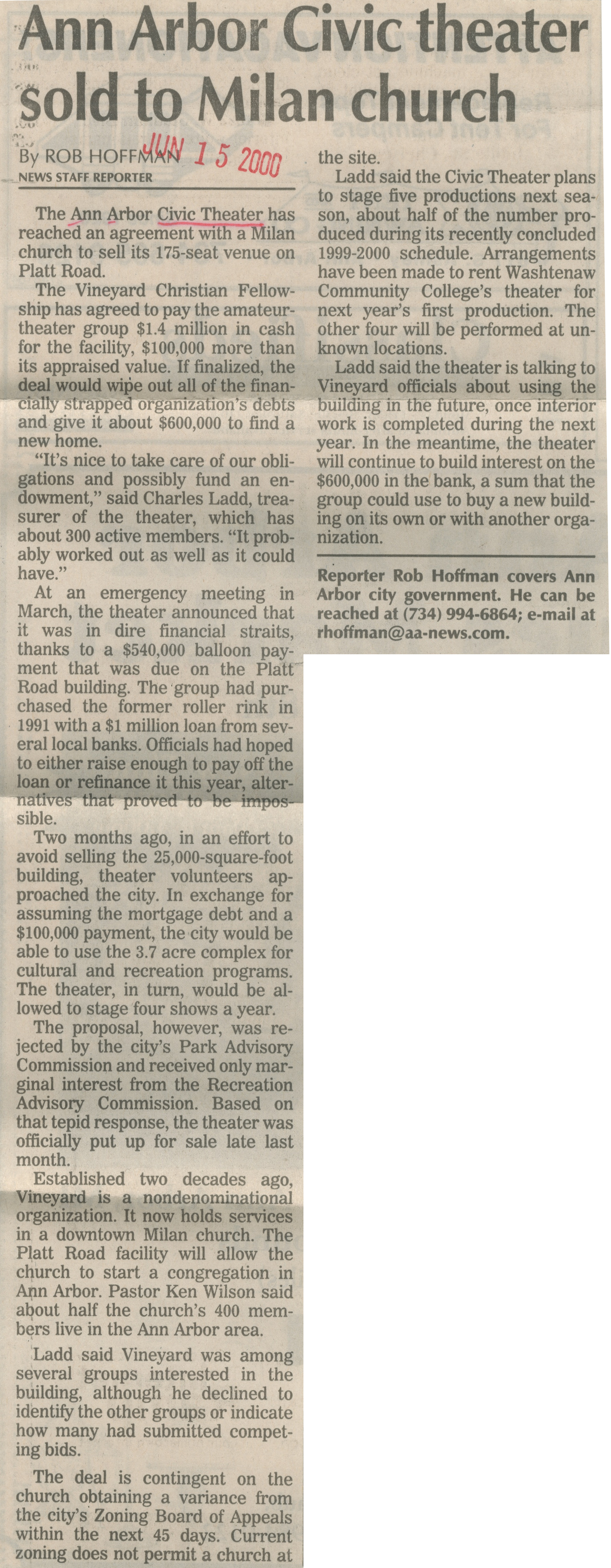
Ann Arbor Takes Flight
In this day and age, when most townies head to Detroit Metro Airport to travel by commercial airplane, it's easy to overlook our own small airfield. In the 1920s--"The Golden Age of Aviation"--Ann Arbor Municipal Airport (ARB/KARB) was front page news. In October of 1928, many well-dressed men and women gathered together on the far edge of our town to celebrate this great achievement. Popping champagne would have been appropriate, if not for prohibition. This was a story of progress, a source of local pride, the scene of many ladies in cloche hats, and a few gentlemen sporting leather aviator caps with large earflaps.
1925 - A Flying Field?
With major advancements in aviation, many airports surfaced across the state of Michigan in the 1920s. On July 2, 1925, an Ann Arbor Times News editorial declared "A flying field, with all the modern conveniences for aviators, is being discussed unofficially in official circles of Ann Arbor...No community of any size will want to be without a landing place within a decade or less." The idea of a local airport was appealing, but ultimately went dormant for a year.


1926 - Steere's Farm Is Suitable
In July of 1926, the Ann Arbor Park Commission launched a serious push for a local airport, and turned their attention to nearly 300 acres in Pittsfield Township. Just south of Ann Arbor, stretched across State Street, this land was already owned by the city. Purchased by Ann Arbor's Water Commission around 1914, the property was farmland, with deep gravel springs supplying much of the city's drinking water. The property also had wetlands, offering the University of Michigan a wide variety of research materials, including venom from resident massasauga rattlesnakes. Formerly owned by retired professor Joseph Beal Steere, the land was still referred to as "Steere's Farm" and "Steere's Swamp". Hackley Butler, park commissioner, and Eli Gallup, park superintendent, collaborated on plans to obtain a portion of the Steere farm property as a site for the flying field. Professor Felix Pawlowski, University of Michigan Aeronautical Engineer, was consulted and gave his stamp of approval. Gallup described Steere's Farm as "lying high, with no obstructions...suitable for the landing of light or heavy planes".
1927 - Airport Site Is Approved
For another year, deliberation swirled around a potential landing field on the Steere's Farm land. Public sentiment toward a local airport shifted in the summer of 1927, when Charles Lindbergh's transatlantic flight made world history. Both of his parents were University of Michigan alumni, which added to the local interest. Ann Arbor residents, like the rest of the country, were suddenly enamored with aviation, and public interest in flying was high. A new airport was now deemed essential to maintain Ann Arbor's reputation as a prosperous, forward-moving municipality.
'AIRPORT SITE IS APPROVED' was a front page Ann Arbor Times News story on November 26, 1927. City aldermen supported using a portion of the Steere's Farm land, and would recommend transfer of the property from the water commission to the park commission. The Chamber of Commerce and City Council both approved the proposal, with assurance that no harm would result to the wells. In early December 1927, 115 acres of Steere's Farm were transferred between city departments. Ann Arbor City Engineer George H. Sandenburgh, immediately began designing an airfield.
January - April 1928, Leonard Flo & The Ann Arbor Flying Club

Lieutenant Leonard Stanley Flo was a city resident for less than five years, but is a permanent part of the Ann Arbor Airport's history. After graduating from U. S. Army Air Corps training in Texas, he served with the First Pursuit Group at Selfridge Field in Michigan. Flo flew as an air mail pilot in Florida, and was also a pilot for the Wise Birds Club in Detroit. He was living on the edge of West Park, near downtown Ann Arbor, as plans came together for a local airfield.
In January 1928, Lt. Flo submitted a letter to the city, proposing himself as manager of the new airport. He suggested a contract giving him responsibility of operating and maintaining the airfield, and allowing him to conduct a flying school on the property. He asked for no compensation from the city, as he would profit from his business, Flo Flying Services. As an experienced flyer, he had inspected the property and found it excellently located with natural advantages for flying facilities. City officials welcomed his proposal, and began drafting a formal agreement in March 1928.

March 1928 also saw the birth of the Ann Arbor Flying Club, a group of Ann Arbor men who joined together to help establish an airport. The list of charter members was essentially a "who's who" of Ann Arbor businessmen, with many joining simply for networking and the status of being involved in the up-and-coming world of aviation. With annual dues starting at $25, equivalent to over $400 a year in 2023, membership was limited to financially privileged citizens. Within a week of being formed, membership in the club jumped to over 100 individuals.
With support from Leonard Flo, and financial assistance from the Ann Arbor Flying Club, work on the new airfield progressed rapidly. By the middle of April 1928, work crews were busy rolling & leveling the land, and installing cinder drainage tiles.

May 19, 1928 - First Landing, 12:05 p.m.
"Fix the date in your mind, and keep it there, because some day you will want to "remember" the first ship at the first airport, an occasion that marked a progressive step by this community." - Ann Arbor Daily News, Editorial, May 19, 1928
In May 1928, Leonard Flo decided to attempt a flight from the Ford Airport in Dearborn onto the Steere Farm property. He hoped to prove to local citizens that a landing could be made on the prepared runway, even after the ground was soaked with several days of spring rain. The Ann Arbor Flying Club had put nearly $5,000 toward the airport project, and the landing was a success.
Accompanying him in a Waco biplane were Eli Gallup, park superintendent, and Harold 'Charlie' Ristine, local news reporter. Gallup was encouraged by the results, and planned for further improvements on the prepared runway, dragging/rolling/tiling a second runway, lighting, and construction of a hangar.
Despite the fact that it was probably really loud and cold in that biplane, Charlie Ristine published a glowing review of his flight in the Ann Arbor Daily News. An editorial lauding the achievement was also printed. A photographer captured photos of the event at the future airport, and the front page of the paper featured an image of the three men smiling and wearing leather aviator caps.
July 17, 1928 - Ann Arbor Airmail Service Inaugurated

Thompson Aeronautical Corporation (TAC), out of Cleveland, Ohio, was awarded one of the early Contract Air Mail routes (CAM 27) from the U.S. Post Office. CAM 27 connected cities from Chicago, Illinois, to Bay City, Michigan, with service starting July 17, 1928. On that date, postal authorities, the Ann Arbor Flying Club, Chamber of Commerce members, and several hundred excited spectators were on hand at the new airport to welcome TAC pilot Lester F. Bishop as he landed his plane in Ann Arbor and received a sack of more than 2,000 letters from Postmaster Ambrose C. Pack. Yet another complimentary editorial ran in the newspaper: "...the fact that the service has been extended to Ann Arbor should be a source of gratification for every resident. It is something to which he can "point with pride," as the saying goes."


October 9, 1928 - Ann Arbor's New Airport Is Dedicated

On a sunny morning in October 1928, three P-1 army first pursuit planes from Selfridge Field circled over Ann Arbor. Commanded by Col. Charles H. Danforth, they touched down on the runways near a crowd of over 350 people, commencing the dedication ceremony of the completed Ann Arbor Municipal Airport. They parked near a Ford Tri-motor (affectionately known as a Tin Goose), a Hamilton Metalplane, and two Spartan planes, which were the property of Flo Flying Services.
The invitation to the dedication, published in the newspaper, noted that all were invited, "including women". Flo Flying Services brought in visitors from surrounding towns by plane, while local residents made their way to the festivities down the rough gravel State Street. City and Washtenaw County officials, members of the Ann Arbor Flying Club, Exchange, Rotary, and Kiwanis clubs were all present. Noted guests included the president of the Hamilton Aircraft Company (owner of the aircraft parked outside), Ford Motor Company's advertising manager, the general manager of the Detroit-Cleveland airline, the assistant traffic manager of Thompson Aeronautical Corporation, and a handful of distinguished pilots. Michigan Governor Fred W. Green was invited, but unable to attend. Guests gathered in the new hangar for a noon luncheon program, which opened with an invocation by Rev. Allison Ray Heaps, pastor of Ann Arbor Congregational Church.

Mayor Edward Staebler addressed the crowd with "Plans for the Future", followed by "A Word from the Council" made by Alderman Herbert Slauson. Levi Wines spoke on "Keeping Abreast With the Times", and Jerome Sutherin, of the Thompson Aeronautical Corporation, spoke about Ann Arbor's airmail service. Shirley Smith, secretary and business manager of the University of Michigan, outlined the history of the new airport, including praise for Eli Gallup and Hackley Butler who had originally championed the idea of a local airfield. Beyond the boasting and self-praise, spectators were most thrilled after the luncheon, when masterful Selfridge Field pilots entertained with "air antics" over the airport.




See For Yourself: Historical Ann Arbor Airport Footage
Ann Arbor History - Aerial Footage of Ann Arbor in the early 1930s, an eight minute video narrated by Al Gallup (son of Eli Gallup), is available on YouTube. If you'd like a glimpse of Leonard Flo in action at the Ann Arbor Municipal Airport, be sure to give it a watch.
Instrumental In Providing Airport

- Read more about Instrumental In Providing Airport
- Log in or register to post comments
Civic Theater To Put Playhouse Up For Sale

- Read more about Civic Theater To Put Playhouse Up For Sale
- Log in or register to post comments
Ann Arbor Civic Theater Sold To Milan Church

- Read more about Ann Arbor Civic Theater Sold To Milan Church
- Log in or register to post comments
Workshop sheds

- Read more about Workshop sheds
- Log in or register to post comments
Community 'Institution,' Ashley Clague, Retiring

- Read more about Community 'Institution,' Ashley Clague, Retiring
- Log in or register to post comments
